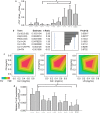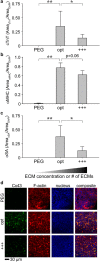An integrated statistical model for enhanced murine cardiomyocyte differentiation via optimized engagement of 3D extracellular matrices
- PMID: 26687770
- PMCID: PMC4685314
- DOI: 10.1038/srep18705
An integrated statistical model for enhanced murine cardiomyocyte differentiation via optimized engagement of 3D extracellular matrices
Abstract
The extracellular matrix (ECM) impacts stem cell differentiation, but identifying formulations supportive of differentiation is challenging in 3D models. Prior efforts involving combinatorial ECM arrays seemed intuitively advantageous. We propose an alternative that suggests reducing sample size and technological burden can be beneficial and accessible when coupled to design of experiments approaches. We predict optimized ECM formulations could augment differentiation of cardiomyocytes derived in vitro. We employed native chemical ligation to polymerize 3D poly (ethylene glycol) hydrogels under mild conditions while entrapping various combinations of ECM and murine induced pluripotent stem cells. Systematic optimization for cardiomyocyte differentiation yielded a predicted solution of 61%, 24%, and 15% of collagen type I, laminin-111, and fibronectin, respectively. This solution was confirmed by increased numbers of cardiac troponin T, α-myosin heavy chain and α-sarcomeric actinin-expressing cells relative to suboptimum solutions. Cardiomyocytes of composites exhibited connexin43 expression, appropriate contractile kinetics and intracellular calcium handling. Further, adding a modulator of adhesion, thrombospondin-1, abrogated cardiomyocyte differentiation. Thus, the integrated biomaterial platform statistically identified an ECM formulation best supportive of cardiomyocyte differentiation. In future, this formulation could be coupled with biochemical stimulation to improve functional maturation of cardiomyocytes derived in vitro or transplanted in vivo.
Figures





References
-
- Hou P. et al. Pluripotent stem cells induced from mouse somatic cells by small-molecule compounds. Science 341, 651–654 (2013). - PubMed
Publication types
MeSH terms
Substances
LinkOut - more resources
Full Text Sources
Other Literature Sources

